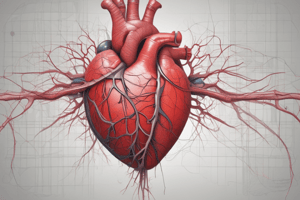Podcast
Questions and Answers
Which of the following coronary arteries is the largest?
Which of the following coronary arteries is the largest?
- Left Anterior Descending Artery (correct)
- Left Circumflex Artery
- Posterior Interventricular Artery
- Right Coronary Artery
Where does the Left Anterior Descending Artery (LAD) run in the heart?
Where does the Left Anterior Descending Artery (LAD) run in the heart?
- Anterior to the interventricular septum (correct)
- Across the left ventricle
- Posterior to the interventricular septum
- Through the anterior interventricular groove
What are the two sets of branches of the Left Anterior Descending Artery (LAD)?
What are the two sets of branches of the Left Anterior Descending Artery (LAD)?
- Proximal and distal branches
- Anterior and posterior branches
- Septal and diagonal branches (correct)
- Left and right branches
What is the consequence of a complete blockage in the Left Anterior Descending Artery (LAD)?
What is the consequence of a complete blockage in the Left Anterior Descending Artery (LAD)?
Which coronary artery typically gives rise to the posterior descending artery?
Which coronary artery typically gives rise to the posterior descending artery?
What is the function of the coronary vessels, including the coronary arteries?
What is the function of the coronary vessels, including the coronary arteries?
Which artery supplies blood to the lateral side and back of the heart?
Which artery supplies blood to the lateral side and back of the heart?
What is the origin of the right coronary artery?
What is the origin of the right coronary artery?
Which artery gives rise to the left marginal artery and posterior descending artery in a left-dominant heart?
Which artery gives rise to the left marginal artery and posterior descending artery in a left-dominant heart?
What is the region of the heart supplied by the posterior interventricular artery?
What is the region of the heart supplied by the posterior interventricular artery?
Which artery supplies blood to the anterior wall of the left ventricle?
Which artery supplies blood to the anterior wall of the left ventricle?
What is the common condition characterized by inflammation and the buildup of plaque in the inner lining of the coronary arteries?
What is the common condition characterized by inflammation and the buildup of plaque in the inner lining of the coronary arteries?
Flashcards are hidden until you start studying
Study Notes
Coronary Vessels: An In-depth Look at the Left Anterior Descending Artery, Left Circumflex Artery, Right Coronary Artery, Posterior Interventricular Artery, and Anterior Interventricular Artery
The coronary vessels, also known as the coronary arteries, are a network of blood vessels that supply blood to the heart muscle. These vessels are essential for the heart's proper functioning, as they deliver oxygen-rich blood to the heart and carry away oxygen-depleted blood. They are divided into two main branches, the left main coronary artery and the right coronary artery, each with distinct roles and variations.
Left Anterior Descending Artery (LAD)
The left anterior descending artery (LAD) is the largest coronary artery, branching off the left main coronary artery. It runs anterior to the interventricular septum in the anterior interventricular groove, extending from the base of the heart to the apex. The LAD has two sets of branches: septal branches that perforate the interventricular septum and diagonal branches that course over the anterior aspect of the left ventricle. The septal branches supply the anterior two-thirds of the septum, while the diagonal branches are numbered from proximal to distal (D1, D2, etc.). Around the apex, the LAD anastomoses with the terminal branches of the posterior descending artery, which is usually a branch of the right coronary artery. A complete blockage in the LAD can cause a "widowmaker" heart attack, which is often fatal.
Left Circumflex Artery
The circumflex artery branches off the left main coronary artery and encircles the heart muscle. It supplies blood to the lateral side and back of the heart. The circumflex artery also gives rise to the left marginal artery and posterior descending artery in a left-dominant heart.
Right Coronary Artery (RCA)
The right coronary artery (RCA) arises from the right aortic sinus of the aorta, above the aortic valve. It supplies blood to the right ventricle, the right atrium, and the sinoatrial and atrioventricular nodes, which regulate the heart rhythm. The RCA divides into smaller branches, including the right posterior descending artery and the acute marginal artery.
Posterior Interventricular Artery
The posterior interventricular artery is a branch of the left main coronary artery that supplies blood to the posterior wall of the left ventricle.
Anterior Interventricular Artery
The anterior interventricular artery is a branch of the left main coronary artery that supplies blood to the anterior wall of the left ventricle.
These coronary vessels play a crucial role in maintaining the heart's function by delivering oxygen-rich blood to the heart muscle and removing oxygen-depleted blood. Any disorder or disease affecting these vessels can lead to reduced blood flow to the heart, potentially causing a heart attack. Coronary artery disease is a common condition characterized by inflammation and the buildup of plaque in the inner lining of the coronary arteries, which can narrow or block the flow of blood to the heart.
Studying That Suits You
Use AI to generate personalized quizzes and flashcards to suit your learning preferences.





